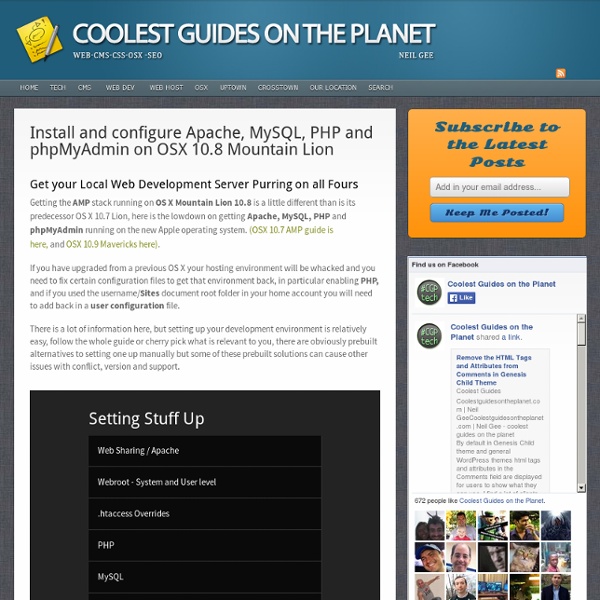Install and configure Apache, MySQL, PHP on OSX 10.8 Mountain Lion

Setup a Subversion Server in 4 Minutes
Home > Code, Linux > Setup a Subversion Server in 4 Minutes Setup a Subversion Server in 4 Minutes You are going to need to type fast but I think you can do it in 4 minutes. These are my notes on what worked for me on my Fedora core 6 with svn lib already installed by the package manager: 1. 2. In that file add these three lines: Create a password file: In that file add a line for your user: 3. (assuming you’ve put your project files in /projects/myrailsproject) 4. Done! Try checking it out of the repository: Since we set anon-access to none you should be prompted for username and password which you created in the file /svnrepos/conf/passwd.
Using NetBeans for WordPress Debugging & Development
NetBeans is an excellent, free IDE (Integrated Development Environment) that is well suited for WordPress website development. Coupled with the free or premium version of DesktopServer and you will have a modern, professional IDE setup. Even if you are already using another editor or development environment like Adobe Dreamweaver (great for design, not so great for debugging), you may still want to give NetBeans a try or use it as your powerful secondary editor. In this post I’ll show you how easy it is to get started and I’ll cover the basics of using NetBeans for WordPress development. NetBeans IDE But first, why NetBeans? Getting Started To get started, you will want to visit the NetBeans download page at ( and install the version specific for PHP and your computer platform (support for both Mac and Windows). First, make sure you have checked the ‘Enable debug services’ check box in DesktopServer. Import Your Project Editing Features
How to enable FTP on iMAC with Mountain
Hi there, I'm having a similar issue relating mainly to accessing the server that my websites are on. I've been using Cyberduck for FTP'ing for a while now but this week I bought a new laptop with Mountain Lion on it. One of my websites I use iWeb and the other is through Wordpress, both of which I can access the server (and transfer files) using Cyberduck. The first time I updated my site it worked. The next day however it didn't - and hasn't since. I have tried using Cyberduck, Coda, Folklift and Transmitter but to no avail. I tried a little App called 'ftpd-enable' but nothing. I've tried all the different commands - like the one for Terminal above - nothing. Rebooted the computer - nothing.
Cookies
Cookies have been around for quite some time on the internet. They were invented to allow webmaster's to store information about the user and their visit on the user's computer. At first they were feared by the general public because it was believed they were a serious privacy risk. This lesson will teach you the basics of storing a cookie and retrieving a cookie, as well as explaining the various options you can set with your cookie. When you create a cookie, using the function setcookie, you must specify three arguments. name: The name of your cookie. In this example we will be creating a cookie that stores the user's last visit to measure how often people return to visit our webpage. PHP Code: Don't worry if you can't follow the somewhat involved date calculations in this example. If your cookie hasn't expired yet, let's retrieve it from the user's PC using the aptly named $_COOKIE associative array. Display: Your last visit was - 11:48 - 02/28/08
Related:
Related:



